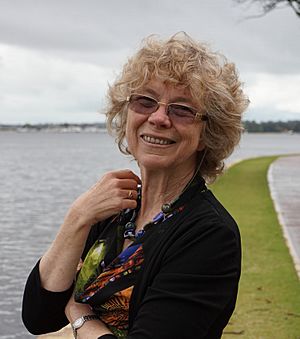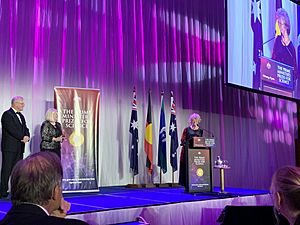Cheryl Praeger facts for kids
Quick facts for kids
Cheryl Praeger
AC FAA
|
|
|---|---|

Praeger by the Swan River in Perth, Western Australia
|
|
| Born | 7 September 1948 |
| Alma mater | |
| Scientific career | |
| Fields |
|
| Institutions | University of Western Australia |
| Doctoral advisor | Peter M. Neumann |
Cheryl Elisabeth Praeger is a famous Australian mathematician. She was born on September 7, 1948, in Toowoomba, Queensland. She is known for her important work in areas of mathematics like group theory, algebraic graph theory, and combinatorial designs.
Professor Praeger earned her first degrees from the University of Queensland. Later, she completed her doctorate at the University of Oxford in 1973. She has written many research papers and helped many students get their PhDs. Today, she is an Emeritus Professor of Mathematics at the University of Western Australia. This means she is a retired professor who is still highly respected.
Contents
Becoming a Mathematician
Early School Days
Cheryl Praeger finished her high school studies at Brisbane Girls Grammar School. After high school, she wanted to learn more about mathematics. She visited a government office for career advice.
The person she spoke with tried to tell her not to study math. He suggested she become a teacher or a nurse instead. He said that two other girls who wanted to study math had not done well.
Even though he tried to discourage her, Cheryl was determined. She felt that an engineering course he showed her did not have enough math. So, she left without much help. But she still went on to get her bachelor's and master's degrees from the University of Queensland.
University Life and Choices
During her time at the University of Queensland, Cheryl met several women who taught mathematics. This made her feel that becoming a mathematician was a normal and good idea. In her first two years, she studied mathematics and physics. After her second year, she decided to focus only on mathematics.
After finishing her studies at the University of Queensland, she had a big choice. She was offered a scholarship to do research at the Australian National University (ANU). But she chose a different path. She took a special scholarship to go to the University of Oxford in England. She attended St Anne's College there. By then, she knew she wanted to study a type of math called algebra.
Starting Her Career
After earning her doctorate degree in 1973, Cheryl Praeger received a research fellowship at ANU. She then had her first chance to teach regular classes at the University of Virginia in the United States.
After that, she returned to ANU. There, she met her future husband, John Henstridge, who was studying statistics. Later, she was offered a short-term job at the University of Western Australia. This short job turned into a long career. She has worked there ever since. In 1989, the University of Western Australia gave her another special degree, a Doctor of Science. This was for her important work on groups of numbers and graph theory.
Cheryl Praeger's Career Highlights
Most of Cheryl Praeger's career has been at the Department of Mathematics and Statistics at the University of Western Australia. She became a full professor in 1983.
She also held many important leadership roles. From 1992 to 1994, she was the head of the Mathematics Department. She was also the first dean of postgraduate research studies from 1996 to 1998. She helped decide who got promoted at the university from 2000 to 2004. She was also a deputy dean for engineering, computing, and mathematics from 2003 to 2006.
Mentoring Future Mathematicians
Professor Praeger has guided more than 30 graduate students in their studies. In 1997, she supervised the research of a student named Akshay Venkatesh. Akshay later won the Fields Medal in 2018. This medal is often called the highest award in mathematics.
Speaking Around the World
Throughout her career, Cheryl Praeger has been invited to speak at many math conferences. These events took her to many countries. She has visited places like Croatia, Canada, China, the USA, the UK, South Korea, Singapore, Sweden, Slovakia, Serbia, Hong Kong, Morocco, Slovenia, France, Germany, Greece, the former USSR, Belgium, Iran, Italy, Pakistan, the Philippines, and Japan.
Awards and Recognitions
Cheryl Praeger has received many awards and honors for her amazing work. She is a Fellow of the Australian Academy of Science. She was also the president of the Australian Mathematical Society from 1992 to 1994. She was the first woman to hold this position.
In 1999, she was made a Member of the Order of Australia. This is a high honor in Australia. In 2021, she was promoted to Companion of the Order of Australia, which is Australia's highest civilian honor.
Here are some of her other awards and honors:
- In 1976, she received a Certificate of Merit for helping to rescue someone from drowning.
- She received honorary Doctor of Science degrees from universities in Thailand (1993), Belgium (2005), Scotland (2015), and Australia (2017).
- In 2003, she received the Centenary Medal from the Australian Government.
- She was named Western Australian Scientist of the Year in 2009.
- In 2011, she received the Moyal Medal. She was the first woman to get this award.
- She became a Fellow of the American Mathematical Society in 2012.
- She was the first woman to receive the Thomas Ranken Lyle Medal (2013) and the George Szekeres Medal (2014).
- In 2015, she was inducted into both the Western Australian Science Hall of Fame and the Western Australian Women's Hall of Fame.
- In 2019, she won the prestigious Prime Minister's Prize for Science.
- In 2021, she received the first Ruby Payne-Scott Medal and Lecture from the Australian Academy of Science.
Awards for Young Mathematicians
Since 2014, there are special awards named after Cheryl Praeger. The Women in Mathematics Special Interest Group gives out the Cheryl E. Praeger Travel Awards to female mathematicians. Also, since 2017, the Australian Mathematics Trust gives the Cheryl Praeger Medal to the best female contestants in the Australian Mathematics Competition.
Professor Praeger has also been a member of many important mathematical groups. These include the Combinatorial Mathematics Society of Australasia and the London Mathematical Society.
Other Important Activities
Cheryl Praeger has been involved in many activities outside of her university work. She was a member of the Prime Minister's Science Advisory Council. She also advised the government on how to get more women involved in science, engineering, and technology.
She has worked with groups that help young people learn math. She was a board member of the Australian Mathematics Trust for many years. From 2001 to 2019, she led the Australian Mathematical Olympiad Committee. This committee helps prepare talented young students for international math competitions. From 2020 to 2025, she was part of the National Science and Technology Council, which advises the Prime Minister.
Professor Praeger has also played a big role in international science groups. She was part of the executive committee of the International Mathematical Union. She also worked with the International Commission on Mathematical Instruction.
From 2014 to 2018, she was the foreign secretary of the Australian Academy of Science. She also led a committee for women in science and engineering for a group called AASSA.
Cheryl Praeger strongly supports women in mathematics. She encourages girls in primary and secondary schools to study math. She does this through lectures, workshops, and special programs like the Family Maths Program Australia.
Personal Life
In August 1975, Cheryl Praeger married John Henstridge in Brisbane. They have two children, James (born 1979) and Tim (born 1982).
Besides her math skills, she is also a talented musician. She holds a special music degree in piano performance. She was part of the University of Western Australia's music group for many years. She has also been an organist and pianist at her church since 1985. Her hobbies include playing keyboard music, sailing, hiking, and cycling.
Her Research Work
Cheryl Praeger published her first research paper in 1970, even before she finished her first university degree. She is now one of the most often cited authors in pure mathematics. As of May 2025, she has published over 480 papers. She is known for working with many other mathematicians, having more than 200 co-authors.
Professor Praeger's research focuses on the mathematics of symmetry. This includes important work in group theory, which studies how things can be rearranged while keeping some properties the same. She also works in combinatorics, analysis of algorithms, discrete mathematics, and geometry.
Some of her key research areas and achievements include:
- She worked with Peter Cameron to prove the Sims conjecture in 1983. This was an early use of the "classification of finite simple groups," which is a huge achievement in math.
- With Jan Saxl and Martin Liebeck, she wrote many papers on different types of groups. They wrote a paper that gave a full proof of the O'Nan–Scott theorem. This theorem helps classify how groups can act on sets of objects.
- Cheryl Praeger later made the O'Nan–Scott Theorem even broader to cover more types of groups.
- She introduced a new way to analyze symmetric graphs. This method uses the classification of finite simple groups to understand graphs where parts can be swapped without changing the overall structure. This is now a standard tool in algebraic graph theory.
- With Peter M Neumann, she helped create the first computer algorithm to recognize certain types of finite groups. This led to a big international project to recognize different matrix groups.
- She has also written several papers on symmetric graphs and distance-transitive graphs with Tony Gardiner.
Selected Publications
- with Martin Liebeck, Jan Saxl: The maximal factorizations of the finite simple groups and their automorphism groups, American Mathematical Society 1990
- with Leonard Soicher: Low rank representations and graphs for sporadic groups, Cambridge University Press 1997
- with Jason Fulman, Peter Neumann: A generating function approach to the enumeration of matrices in classical groups over finite fields, American Mathematical Society 2005
- with Martin Liebeck, Jan Saxl: Regular subgroups of primitive permutation groups, American Mathematical Society 2010
- with Csaba Schneider: Permutation Groups and Cartesian Decompositions, Cambridge University Press 2018


